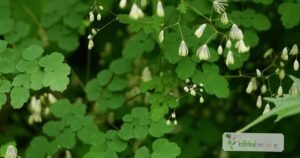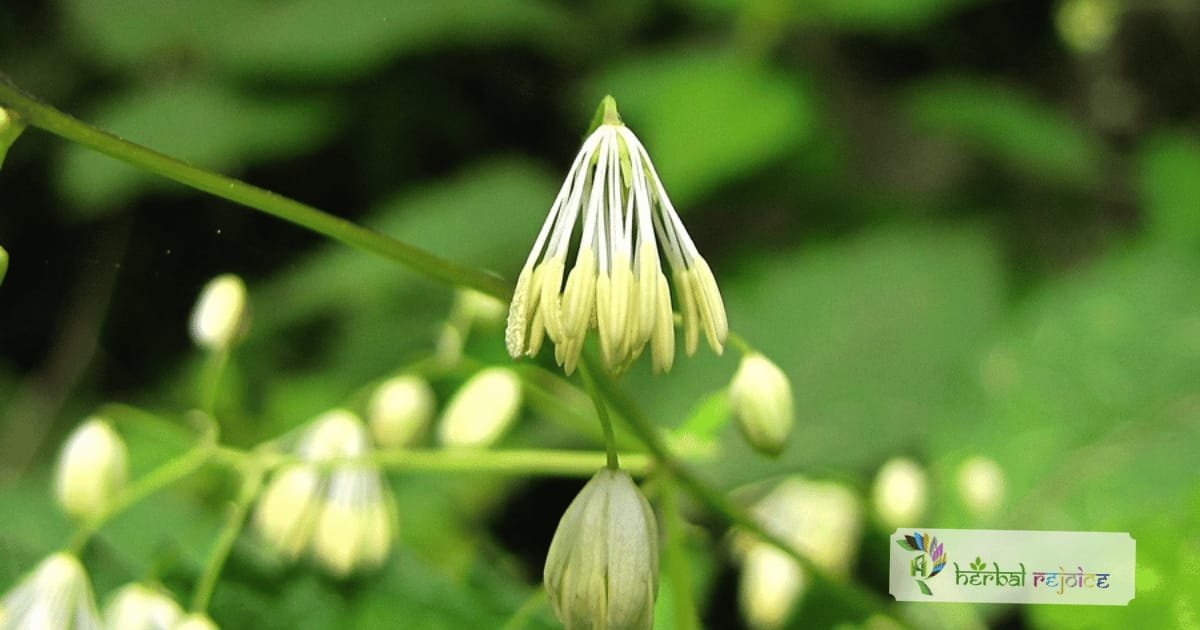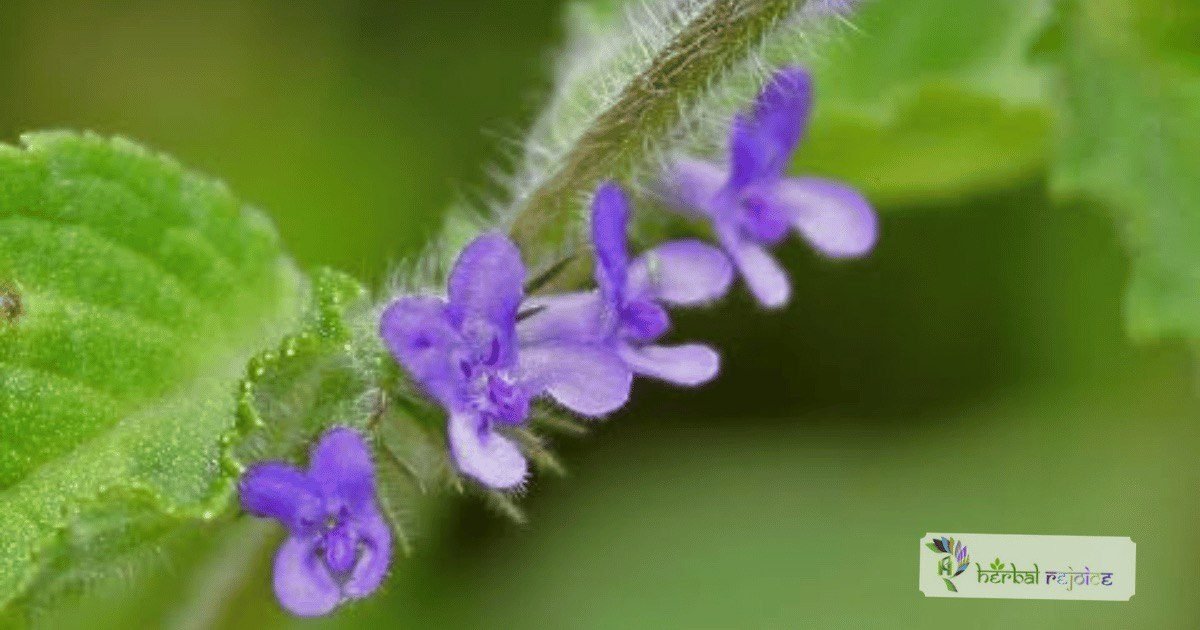Introduction
Thalictrum foliolosum DC., also known as Pitarangaa or Piyaaraangaa in Ayurveda and Mamiri in Unani, is a plant belonging to the Ranunculaceae family. Pitarangaa has been used in Ayurveda and Unani medicine for its therapeutic properties, particularly in treating gout, rheumatism, and fevers.
It is native to the temperate regions of the Himalayas, specifically found at altitudes between 1,500 to 2,400 meters. This plant can be found in various regions such as the Khasi hills, Kashmir, Punjab, Delhi, Uttar Pradesh, Bihar, and Orissa.

Traditional Uses Of Pitaangaa
Thalictrum foliolosum DC. has been traditionally used in herbal medicine for its therapeutic properties. The plant is known to be effective against gout and rheumatism.
The roots of the plant have febrifuge and antiperiodic properties, making it useful in treating fevers. Additionally, the bitter tonic derived from the roots is beneficial during the recovery phase of illness.
Chemical Constituents of Pitarangaa
The root of Thalictrum foliolosum DC. contains alkaloids berberine and magnoflorine. Berberine is known to stimulate the movement of the gastrointestinal tract and has a depressant effect on the heart.
Magnoflorine, on the other hand, induces hypotension. After six months, the berberine content is reduced by one-fourth, while the magnoflorine content becomes negligible. The root also contains palmitine and jatrorrhizine.
The alkaloidal structure of Thalictrum sp. exhibits antitumoral activity. Over 60 isoquinoline and diterpenoid alkaloids have been isolated from the various species of Thalictrum in India.
Other Species Of Pitarangaa
In India, there are approximately 17 species of Thalictrum sp. that can be found. Some of the notable species include T. alpinum Linn., found in the alpine Himalayas and western Tibet at altitudes between 3,000 and 5,100 meters.
T. elegans Wall. ex Royle is found in the sub-alpine Himalayas from Kashmir to Sikkim at altitudes ranging from 3,000 to 3,900 meters.
T. foetidum Linn. is found in the North-West Himalayas, while T. javanicum Blume is found in the temperate Himalayas, including Kashmir, Sikkim, Khasi hills, Kodaikanal, and Nilgiri hills.
T. minus Linn. is found in the temperate Himalayas, and T. reniforme Wall. is found in the temperate Himalayas at altitudes between 2,400 to 3,000 meters.
Conclusion
In conclusion, Thalictrum foliolosum DC. is a medicinal plant found in the Himalayas. It has been used in Ayurveda and Unani medicine for its therapeutic properties, particularly in treating gout, rheumatism, and fevers.
The root of the plant contains alkaloids like berberine and magnoflorine, which have various physiological effects. There are several species of Thalictrum found in India, each with its unique properties.
Frequently Asked Questions (FAQs)
What is Thalictrum foliolosum DC.?
Thalictrum foliolosum DC. is a plant native to the Himalayas, belonging to the Ranunculaceae family.
What are the traditional uses of Thalictrum foliolosum DC.?
Thalictrum foliolosum DC. has been traditionally used in herbal medicine for treating gout, rheumatism, and fevers.
Which regions can Thalictrum foliolosum DC. be found in?
Thalictrum foliolosum DC. can be found in various regions such as the Khasi hills, Kashmir, Punjab, Delhi, Uttar Pradesh, Bihar, and Orissa.
What are the therapeutic properties of Thalictrum foliolosum DC.?
Thalictrum foliolosum DC. is known to have febrifuge and antiperiodic properties, making it beneficial in treating fevers.
What are the alkaloids present in the root of Thalictrum foliolosum DC.?
The root of Thalictrum foliolosum DC. contains alkaloids such as berberine, magnoflorine, palmitine, and jatrorrhizine.
What is the effect of berberine found in Thalictrum foliolosum DC.?
Berberine stimulates the movement of the gastrointestinal tract and has a depressant effect on the heart.
What is the effect of magnoflorine found in Thalictrum foliolosum DC.?
Magnoflorine induces hypotension.
How long does it take for the berberine content to reduce in Thalictrum foliolosum DC. root?
After six months, the berberine content in the root is reduced by one-fourth.
How many species of Thalictrum can be found in India?
Approximately 17 species of Thalictrum can be found in India.
What are some notable species of Thalictrum in India?
Some notable species of Thalictrum in India include T. alpinum, T. elegans, T. foetidum, T. javanicum, T. minus, and T. reniforme.
Where is T. alpinum found?
T. alpinum is found in the alpine Himalayas and western Tibet at high altitudes.
What is the altitude range for T. elegans?
T. elegans is found in the sub-alpine Himalayas from Kashmir to Sikkim at altitudes ranging from 3,000 to 3,900 meters.
Where is T. foetidum found?
T. foetidum is found in the North-West Himalayas.
Which regions are T. javanicum found in?
T. javanicum is found in the temperate Himalayas, including Kashmir, Sikkim, Khasi hills, Kodaikanal, and Nilgiri hills.
Where is T. minus found?
T. minus is found in the temperate Himalayas.
What is the altitude range for T. reniforme?
T. reniforme is found in the temperate Himalayas at altitudes between 2,400 to 3,000 meters.
What physiological effects do the alkaloids in Thalictrum sp. have?
The alkaloids in Thalictrum sp. exhibit antitumoral activity.
How many isoquinoline and diterpenoid alkaloids have been isolated from Thalictrum in India?
Over 60 isoquinoline and diterpenoid alkaloids have been isolated from various species of Thalictrum in India.
What is the potential of Thalictrum species in medicine?
Thalictrum species have potential in medicine due to their therapeutic properties and the presence of various alkaloids.
What further studies are needed regarding Thalictrum species?
Further studies are needed to explore the full potential and medicinal uses of Thalictrum species.





